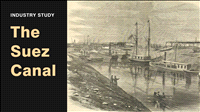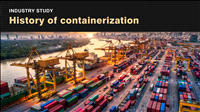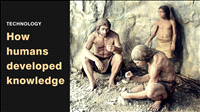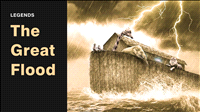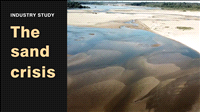The sand crisis | The world is slowly running out of sand | Industry study
By Kiron Kasbekar | 20 Nov 2022
I’m sure you’ve seen news reports about food shortages in the world, such as the one triggered by the Ukraine war that began on 24th February 2022.
Food prices were already up 20% before the war broke out, compared to a year earlier, according to the Food and Agriculture Organization. The war in Ukraine resulted in a further increase, and March 2022 food prices were 40% higher compared to March 2021.
The war has added to an already serious crisis caused by climate-related crop failures. And all hopes of reducing hunger and malnutrition have got shattered.
Wars get the most news coverage everywhere in the world. But there are other crises that draw public attention.
The Covid-19 pandemic, a once-in-a-lifetime kind of event, which had cornered the world’s attention for two years running, has already set back growth besides causing more than six and a half million deaths around the world. Countries are still stumbling out of that crisis.
Another very serious crisis is the water crisis. You must have heard about the water shortages people are facing in California in the US, in Cape Town in South Africa, in parts of India, in many Middle Eastern countries.
Now the crisis in Ukraine has sharpened another crisis that was already troubling the world. And that is the energy crisis, which is a result of a combination of the pandemic, slowdowns in supply chains, and hot weather that is one of the results of the climate change that has begun to trouble the world.
So we are going through one crisis after another.
But have you heard about the world sand crisis?
Sand crisis?
Why should there be a sand crisis? Isn’t there enough sand all over the world? On seashores and lake shores, along rivers, and in big and small deserts across the world?
With so much sand around the world, why do we need to worry about a sand crisis?
Well, we do.
It’s not a question of how much sand there is in the world. The question is what type of sand is available. And sand of the type that is used in many industrial applications, which we were accustomed to getting virtually free of cost, is becoming harder to find.
The situation has become so bad that it has led to a new crime wave.
There are ‘sand mafias’ in many parts of the world that have been mining sand illegally from river beds, heedless of the damage that does to the environment. These mafias have become very powerful and enjoy political patronage.
Voluntary organizations have opposed them, but there is so much money in sand that some of the sand mafias have ruthlessly murdered people who have opposed their illegal mining of sand.
I’ll explain why this is happening, in just a few minutes. But before that, let me explain how important sand is for our civilization today. It needs to be explained because most people do not realize how important it really is.
Most people probably would ask how something like sand can be precious when people walk all over it on sea beaches and river beaches.
Think about it.
If you ask a group of people to list the most important materials in the world, you can bet they’d say something like this: steel, aluminum, copper, plastic, paper, cement, maybe silver and gold … and some smart ones would even include stuff like nickel, lead, carbon, uranium, and molybdenum.
How many people would list sand in their list of important materials? My guess is: none, or maybe one out of hundred, or a thousand.
If you then mention sand, a few people may raise their hands and say, ‘Oh yes, sand, it’s used in the making of concrete, isn’t it?’
Yes, it is used to make concrete, and it is used to make glass too.
And concrete and glass are two very important components of any modern building, especially in the cities.
Sand also goes into making concrete, asphalt or tar roads.
But these are not the only sectors that depend on sand.
All devices that use semiconductor chips, for example, depend on sand as a basic raw material.
Now semiconductors are used not only in computers and mobile phones, but in every electronic device we use – and that works out to a very large number of things we use today.
Here are a few more examples: cars and other vehicles, cameras, microwaves, water purifiers, washing machines, refrigerators, solar panels, hospital equipment, office equipment, scientific instruments … the list is endless.
Sand is also used in the process of drilling for petroleum and gas. It is used in the hydraulic fracturing process commonly known as fracking that is used in the oil drilling business. With fracking, a mixture of sand and water is injected with great force into tight oil formations to break the shale rock and make it easier to extract the oil in the rock.
And then you have stuff like toothpastes that use silicates.
Surprised? Frankly, when I started doing my research for this video, I never expected to find toothpastes in the list of products that use stuff derived from sand. But some toothpastes do use what is called hydrated silica.
Sand is also used for land reclamation and for flood protection in coastal areas, prevention of erosion of the coasts and addressing climate change impacts such as the rise in sea levels.
Some countries are using sand and rocks to ‘reclaim land from the sea’.
These include Singapore, Hong Kong, the Philippines, China, and the Netherlands.
Talking of reclamation, I must say something here about what happened more than two centuries ago in the area now known as Bombay (or Mumbai).
I don’t know how many of you know this – but Mumbai, or Bombay, as it came to be called afterwards, was built on land largely reclaimed from the sea. Mumbai, named after Mumbadevi, the goddess worshipped by the fisher-folk who inhabited the island, was itself one of seven islands.
The other six islands were called Colaba, Little Colaba, both to the south, and Mazagaon, Worli, Parel, and Mahim to the north. These islands were separated by big stretches of the sea.
In 1782, William Hornby assumed the office of Governor of Bombay, and initiated the Hornby Vellard engineering project of uniting the seven islands into a single landmass.
In 1784, the Hornby Vellard project was completed and soon reclamations at Worli and Mahalaxmi followed. The word ‘Vallad’, incidentally, means ‘fence’ in Portuguese, the colonists who controlled the Bombay islands before the British took over. Perhaps they used that word because the area was fenced off, or fortified.
Two causeways were built to connect the now-joined Bombay islands to the mainland – one in the east at Sion, and the other in the west at Mahim.
Commuters today do not even realize that there was ever an island there where south and central Bombay are today, let alone seven islands!
They must have used up a huge amount of sand, gravel and crushed stone brought in from the mainland.
But do remember – Bombay was created a few centuries ago, when the world did not face the kind of environmental problems it is facing today.
You do find a few instance of countries trying to create land in the shallows of the sea by pouring large quantities of sand, gravel and crushed stone into the water. China and the UAE have created islands in the sea in recent times, and Singapore is expanding its landmass by similarly reclaiming land from the sea. But these are rare examples of such territorial expansion.
Anyway, landfills are a small part of sand usage today. A bulk of it used in construction.
According to McKinsey & Company, construction-related spending accounts for 13% of the world's GDP! And that includes concrete and glass, both of which use up large quantities of sand.
Watch full video: https://youtu.be/-njI9rC2E-Y














